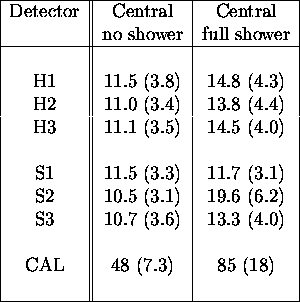As indicated above, we used HIJET to simulate Au-Au interactions. The parameter CENTRA was set to 5 for most of our studies. This selects the central few percent of the cross section, which is expected to correspond to events selected by our multiplicity trigger. In addition, HIJET includes secondary interactions, the nucleon Fermi momentum distribution, and uses a Wood-Saxon nucleon potential. The rescattering parameter was set to 3.25, which reproduces existing AGS multiplicity data.
For single particle production we used the following model:
![]()
where:
![]()
![]()
![]()
with cutoffs:
![]()
![]()
GEANT is used to track particles produced by either generator through the
apparatus. All physics processes were turned on in GEANT; these include
Gaussian multiple scattering, decays, hadronic interactions, Compton
scattering, pair production, and positron annihilation. Energy loss with Landau
fluctuations including ![]() -ray production is used to compute the energy
deposited in the tracking detectors. The arrival time for each energy
deposition is also calculated. All interactions in the collimators, magnet pole
tips, vacuum chamber walls, etc. were simulated for the shielding hits library.
Finally, standard GEANT momentum cutoffs were used. Studies showed that the
results did not change if the momentum cutoffs were lowered.
-ray production is used to compute the energy
deposited in the tracking detectors. The arrival time for each energy
deposition is also calculated. All interactions in the collimators, magnet pole
tips, vacuum chamber walls, etc. were simulated for the shielding hits library.
Finally, standard GEANT momentum cutoffs were used. Studies showed that the
results did not change if the momentum cutoffs were lowered.
The output from GEANT was stored in the form of ``hits banks'' for each
detector for each event. The hits files have x, y, z, TOF, ![]() E for each
particle which deposits energy in a detector.
E for each
particle which deposits energy in a detector.
To give a feeling for the nature of the events from the simulation we show a typical
event. Figure ![]() shows the spectrometer magnets, collimator, part
of the vacuum chamber, and the detectors as described in GEANT. In Fig.
shows the spectrometer magnets, collimator, part
of the vacuum chamber, and the detectors as described in GEANT. In Fig. ![]() a typical central Au-Au interaction is shown overlaid on the detector. One can see
a typical central Au-Au interaction is shown overlaid on the detector. One can see
Figure: E864 Apparatus as entered into GEANT.
Figure: Typical central Au-Au interaction tracked by GEANT through the E864 Apparatus.
Dashed or dotted lines are neutral particles.
Figure: Central Au-Au interaction with tracks from shielding included. Dashed or dotted lines
are neutral particles
that interactions in the detectors and air are included. In Fig. ![]() tracks from the collimators and other non-detector material are included. One should
note that these figures are highly anamorphic - hence the appearance of very wide angle
tracks from the shielding is somewhat deceiving. Dotted or dashed lines represent neutral
particles and particle trajectories are not drawn inside the magnet iron or shielding.
Figure
tracks from the collimators and other non-detector material are included. One should
note that these figures are highly anamorphic - hence the appearance of very wide angle
tracks from the shielding is somewhat deceiving. Dotted or dashed lines represent neutral
particles and particle trajectories are not drawn inside the magnet iron or shielding.
Figure ![]() shows the longitudinal origin of all proton and neutron
tracks which produced hits in any detector from GEANT tracing a sample of HIJET central
Au-Au collisions. (Tracks from shielding interactions are not included in this plot.)
There are a total of
shows the longitudinal origin of all proton and neutron
tracks which produced hits in any detector from GEANT tracing a sample of HIJET central
Au-Au collisions. (Tracks from shielding interactions are not included in this plot.)
There are a total of
Figure: Longitudinal origin of all proton and neutron tracks which produced hits
in any detector from GEANT tracing a sample of HIJET central Au-Au collisions.
(Horizontal scale is meters from target.)
3.88 x 10 ![]() tracks in the histogram. Almost 2/3 of these tracks come from the
interaction target. The remaining 1/3 come from decays and interactions in the
detectors, vacuum window and air downstream of the vacuum window.
All these processes are included in our simulations.
tracks in the histogram. Almost 2/3 of these tracks come from the
interaction target. The remaining 1/3 come from decays and interactions in the
detectors, vacuum window and air downstream of the vacuum window.
All these processes are included in our simulations.
Table ![]() gives the
average number of hits in the detectors for various types of events.
As noted in the section on ``Magnets, Collimators and Vacuum Chamber'' there is a significant
increase in the number of particles entering the calorimeter (about a factor of 2) due to the
interactions in the collimators and shielding, but almost all of the increase is from very low
energy photons which should have little effect on the performance of the calorimeter.
gives the
average number of hits in the detectors for various types of events.
As noted in the section on ``Magnets, Collimators and Vacuum Chamber'' there is a significant
increase in the number of particles entering the calorimeter (about a factor of 2) due to the
interactions in the collimators and shielding, but almost all of the increase is from very low
energy photons which should have little effect on the performance of the calorimeter.

Table: Average hit multiplicities for central events in the E864 detectors with and without
extra track from showers in the shielding.(Parentheses show RMS spreads.)